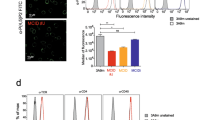Summary
The roles that Ca2+, calmodulin, and ATP play in the redistribution of conconavalin A (Con A) binding sites on the surface of mouse T-lymphoma cells were examined. Membranes of cells labeled with fluorescein-conjugated Con A (Fl-Con A) were made permeable (“skinned”) to ions and proteins by incubation in a solution containing no added Ca2+, 7mm EGTA, and ATP. The intracellular ionic and protein concentrations could then be varied, and the degree of Con A receptor capping monitored simultaneously. A graded increase (9.0 to 30%) was found in the number of capped cells with increasing Ca2+ concentration from 10−6–10−4.9 m. Increasing concentrations of trifluoperazine, chlorpromazine, and promethazine (1.5×10−6 to 1.0×10−4 m) in cell suspensions containing 10−4 m Ca2+ produced graded inhibition of capping in the same order that the drugs bind to calmodulin. Removal of extracellular Ca2+ dissociated (reversed) some of the caps into patches, thus reducing their number (12%). ATP was required for either capping or cap dissociation to occur. Addition of calmodulin (3.9×10−8–6.3×10−7 m) to the cell suspension increased the Ca2+ sensitivity. These results provide direct evidence that capping of Con A receptors is a reversible process (i) regulated by intracellular Ca2+ concentration, (ii) requiring ATP as an energy source, and (iii) susceptible to the influence of calmodulin. These findings are consistent with the hypothesis that the collection of surface receptor patches into cap structures is controlled by the interaction of actomyosin filaments, which in turn is regulated by a Ca2+-calmodulin-activated control system.
Similar content being viewed by others
References
Adelstein, R.S., Conti, M.A. 1975. Phosphorylation of platelet myosin increases actin-activated myosin ATPase activity.Nature (London) 256:597–598
Adelstein, R.S., Klee, C.B. 1981. Purification and characterization of smooth muscle myosin light chain kinase.J. Biol. Chem. 256:7501–7509
Bourguignon, L.Y.W., Balazovich, K. 1980. Effect of the anti-depressant drug-Stelazine on lymphocyte capping.Cell Biol. Int. Rep. 4(10):947–952
Bourguignon, L.Y.W., Pressman, B.C. 1983. Stimulation of lymphocyte receptor capping by the ionophore, monensin.J. Membrane Biol. 73:91–93
Bourguignon, L.Y.W., Singer, S.J. 1977. Transmembrane interactions and the mechanism of capping of surface receptors by their specific ligands.Proc. Natl. Acad. Sci. USA 74(11):5031–5035
Bourguignon, L.Y.W., Tokuyasu, K.T., Singer, S.J. 1978. The capping of lymphocytes and other cells studied by an improved method for immunofluorescence staining of frozen sections.J. Cell Physiol. 95:239–257
Braun, J. Fujiwara, K., Pollard, T.D., Unanue, E.R. 1978. Two distinct mechanisms for redistribution of lymphocyte surface molecules: II. Contrasting effects of local anesthetics and calcium ionophore.J. Cell. Biol. 79:419–426
Butman, B.T., Bourguignon, G.J., Bourguignon, L.Y.W. 1980. Lymphocyte capping induced by polycationized ferritin.J. Cell Physiol. 105:7–15
Cassidy, P., Hoar, P.E., Kerrick, W.G.L. 1980. Irreversible thiophosphorylation and activation of tension in functionally skinned rabbit ileum strips by [γ-35S] ATPγS.J. Biol. Chem. 254:11148–11153
Chacko, S., Conti, M.A., Adelstein, R.S. 1977. Effect of phosphorylation of smooth muscle myosin in actin and Ca2+ regulation.Proc. Natl. Acad. Sci. USA 74:129–133
Crouch, T.H., Holroyde, M.J., Collins, J.H., Solaro, R.J., Potter, D.J. 1981. Interaction of calmodulin with skeletal muscle myosin light chain kinase.Biochemistry 20:6318–6325
Crouch, T.H., Klee, C.B. 1980. Positive cooperative binding of calcium to bovine brain calmodulin.Biochemistry 19:3692–3698
Dabrowska, R., Hartshorne, D.J. 1978. A Ca2+ and modulator-dependent myosin light chain kinase from non-muscle cells.Biochem. Biophys. Res. Commun. 85:1352–1359
Fay, F.S., Shlevin, H.H., Granger, W.C., Jr., Taylor, S.R. 1979. Aequorin luminescence during activation of single isolated smooth muscle cells.Nature (London) 280:506–508
Hoar, P.E., Kerrick, W.G.L., Cassidy, P.S. 1979. Chicken gizzard: Relation between calcium-activated phosphorylation and contraction.Science 204:503–506
Huxley, H.E. 1972. Molecular basis of contraction in crossstriated muscle.In: The Structure and Function of Muscle, G.H. Bourne, editor, pp. 302–388. Academic Press, New York
Kerrick, W.G.L. 1981. Myosin light chain kinase in skinned fibers.In: Calcium and Cell Function, W.Y. Cheung, editor, Vol. II, pp. 279–295. Academic Press, New York
Kerrick, W.G.L., Donaldson, S.K.B. 1972. The effects of Mg2+ on submaximum Ca2+-activated tension in skinned fibers of frog skeletal muscle.Biochim. Biophys. Acta 275:117–122
Kerrick, W.G.L., Hoar, P.H., Cassidy, P.S. 1980. Calcium-activated tension: The role of myosin light chain phosphorylation.Fed. Proc. 39:1558–1563
Kerrick, W.G.L., Hoar, P.E., Cassidy, P.S., Bolles, L.L., Malencik, D.A. 1981. Calcium-regulatory mechanisms: Functional classification using skinned fibers.J. Gen. Physiol. 77:177–190
Kerrick, W.G.L., Krasner, B. 1975. Disruption of the sarcolemma of mammalian skeletal muscle fibers by homogenization.J. Appl. Physiol. 39:1052–1055
Klee, C.B., Crouch, T.H., Richman, P.G. 1980. Calmodulin.Annu. Rev. Biochem. 49:469–515
Nelson, GA., Andrews, M.L., Karnovsky, M.J. 1982. Participation of calmodulin in immunoglobulin capping.J. Cell Biol. 95:771–780
Poste, G., Nicolson, G.L. 1976. Calcium ionophores A23187 and X537A affect cell agglutination by lectins and capping of lymphocyte surface immunoglobulins.Biochim. Biophys. Acta 426:148–155
Pozzan, T., Arslan, P., Tsien, R.Y., Rink, T.J. 1982. Anti-immunoglobulin, cytoplasmic free calcium, and capping in B lymphocytes.J. Cell Biol. 94:335–340
Salisbury, J.L., Condeelis, J.S., Maihle, N.J., Satir, P. 1981. Calmodulin localization during capping and receptor-mediated endocytosis.Nature (London) 294:163–166
Schreiner, G.F., Unanue, E.R. 1976. Membrane and cytoplasmic changes in lymphocytes induced by ligand-surface immunoglobulin interaction.Adv. Immunol. 24:37–165
Sobieszek, A. 1977. Ca2+-linked phosphorylation of a light chain of vertebrate smooth-muscle myosin.Eur. J. Biochem. 73:477–483
Taylor, R.B., Duffus, P.H., Raff, M.C., Petris, S. de 1971. Redistribution and pinocytosis of lymphocyte surface immunoglobulin molecule induced by anti-immunoglobulin antibody.Nature New Biol. 233:225–229
Wang, J.H., Desai, R. 1977. Modulator binding protein. Bovine brain protein exhibiting the Ca2+-dependent association with the protein modulator of cyclic nucleotide phosphorylation.J. Biol. Chem. 252:4175–4184
Weiss, B., Levin, R.M. 1978. Mechanism for selectively inhibiting the activation of cyclic nucleotide phosphodiesterase and adenylate cyclase by antipsychotic agents.In: Advances in Cyclic Nucleotide Research. W.J. George, and L.J. Ignarro, editors. pp. 285–303. Raven Press, New York
Author information
Authors and Affiliations
Rights and permissions
About this article
Cite this article
Bourguignon, L.Y.W., Kerrick, W.G.L. Receptor capping in mouse T-lymphoma cells: A Ca2+ and calmodulin-stimulated ATP-dependent process. J. Membrain Biol. 75, 65–72 (1983). https://doi.org/10.1007/BF01870800
Received:
Revised:
Issue Date:
DOI: https://doi.org/10.1007/BF01870800




